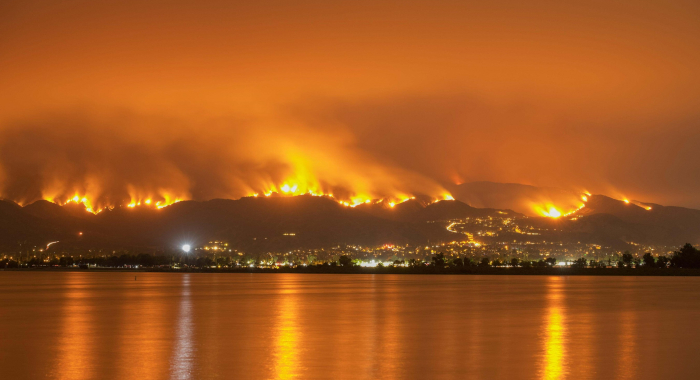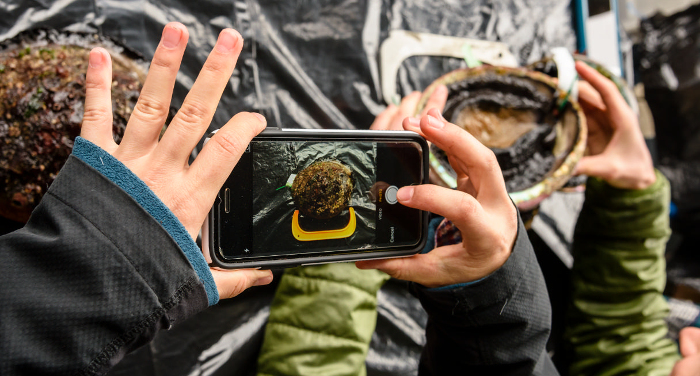Technology is enabling conservation scientists to collect and analyze data with an efficiency unimagined just decades ago. Satellite and drone-based remote sensing allow rapid mapping and monitoring of environmental conditions; networked sensors such as camera traps and flow meters provide real-time data about the health and potential threats to important resources.
Data are fundamental to making science-based conservation decisions. By modernizing environmental data capture and analysis and streamlining the delivery of usable information to decision makers, we can unlock new opportunities for transformative change in resource management.
The Conservancy’s team of designers, engineers, and data scientists are continually applying new applications of technology to increase the pace and scale of conservation in California – and beyond.


Roland Geyer, Jenna Gavigan, Alexis M. Jackson, Vienna R. Saccomanno, Sangwon Suh, Mary G. Gleason
Synthetic microfibers are the most prevalent type of microplastic and apparel washing is a major source of microfiber pollution. Using California as a case study to estimate the magnitude of…Jessica Morten, Ryan Freedman, Jeffrey D. Adams, Jono Wilson, Aliya Rubinstein, Sean Hastings
The great whales, including, blue, humpback, and fin whales are threatened by collisions with ocean going vessels. Global shipping traffic is projected to increase up to 12-fold in coming decades.…Brandon Kuczenski, Camila Vargas Poulsen, Eric L. Gilman, Michael Musyl, Roland Geyer, Jono Wilson
More than 4.5 million fishing vessels ply ocean waters each year, setting countless nets, traps, hooks and lines. Much of this fishing gear is made of plastic components and a significant fraction of…William J. Harford, Ricardo Amoroso, Richard J. Bell, Matias Caillaux, Jason Marc Cope, Dawn Dougherty, Natalie Anne Dowling, Frank Hurd, Serena Lomonico, Josh Nowlis, Dan Ovando, Ana M. Parma, Jeremy D. Prince, Jono R. Wilson
Overfishing threatens the health of ocean ecosystems. Effective fisheries management is key to minimizing ocean impacts and improving outcomes for millions of fishing dependent people throughout the…Theodore E. Grantham, Daren M. Carlisle, Jeanette Howard, Belize Lane, Robert Lusardi, Alyssa Obester, Samuel Sandoval-Solis, Bronwen Stanford, Eric D. Stein, Kristine T. Taniguchi-Quan, Sarah M. Yarnell, Julie K. H. Zimmerman
Protecting water in rivers is made more challenging by the lack of quantitative estimates of the amount of water required to protect river ecosystems. The authors developed a model and made…Moses Katkowski, H. Scott Butterfield, John Knapp, Kelly Easterday, Laura Riege, Mark Reynolds
This 5-year action plan describes the vision for invasive plant species mapping, monitoring and treatment at the Jack and Laura Dangermond Preserve in Sourthern California. The plan is adaptive and…Kelsey Jessup, Sophie S. Parker, John M. Randall, Brian S. Cohen, Rowan Roderick-Jones, Shona Ganguly, Jill Sourial
This paper presents results from Planting Stormwater Solutions, part of TNC’s Urban Conservation work in Los Angeles. The authors develop a methodology to prioritize siting of vegetated…Robert I. McDonald, Tanushree Biswas, Cedilla Sachar, Ian Housman, Timothy M. Boucher, Deborah Balk, David Nowak, Erica Spotswood, Charlotte K. Stanley, Stefan Leyk
Urban tree cover provides benefits to human health and well-being, but it is often inequitably distributed. In this study, researchers Google Earth Engine (GEE) and an automated machine learning…Alyssa E. Semerdjian, H. Scott Butterfield, Robert Stafford, Michael F. Westphal, William T. Bean
This paper in the Journal of Wildlife Management combines nearly 20 years of remote sensing, field/trapping, and modeling data to develop a new approach to the identification and prioritization of…Kirk Klausmeyer, Jeanette Howard, Melissa Rohde, Charlotte Stanley
The first step to sustainably manage groundwater dependent ecosystems (GDEs) is to identify where they are. The Nature Conservancy developed a statewide spatial database that provides locations of…Tom Baribault, Daniel Porter, Jessica Burton Desrocher, Douglas Larmour, Mark Rasmussen, Roy Anderson
The Tahoe-Central Sierra Initiative (TCSI) area has seen recent megafires and is highly developed, making the risk new of human-caused wildfire ignitions high. In this report, experts from Mason Bruce…Daniel Porter, Robert Longcor
Forests of the Sierra Nevada and across the western U.S. are under unprecedented threat from catastrophic wildfire, insect outbreaks, and drought. In this briefing paper, which was developed as a…Sydney J. Chamberlin, Michelle Passero, Ashley Conrad-Saydah, Tanushree Biswas, Charlotte K. Stanley
California’s natural and working lands – its forests, grasslands, wetlands, farmlands, rangeland, and urban green spaces – provide Californians with numerous environmental, social,…Mary Kang, Debra Perrone, Ziming Wang, Scott Jasechko, Melissa M. Rohde
To ensure that California’s groundwater is sustainably managed in the future and over the long-term, current state definitions of what constitutes groundwater may need to be revised, according…Sophie S. Parker, Andy Zdon, William T. Christian, Brian S. Cohen, Maura Palacios Mejia, Naomi S. Fraga, Emily E. Curd, Kiumars Edalati, Mark A. Renshaw
This paper presents results from the Mojave Desert Springs research project, and discusses why the conservation of these groundwater-dependent ecosystems is so critical to biodiversity. The authors…Maura Palacios Mejia, Emily Curd, Kiumars Edalati, Mark A. Renshaw, Roy Dunn, Daniel Potter, Naomi Fraga, Jenna Moore, Justin Saiz, Robert Wayne, Sophie S. Parker
This paper presents results from the Mojave Desert Springs research project. The authors used an environmental DNA (eDNA) technique to assess biodiversity at four naturally occurring springs. They…Brian Cohen, Kelsey Jessup, Sophie Parker, John Randall, Jill Sourial
Cities across Southern California are investing in new infrastructure to address the challenges of stormwater management. We promote the use of nature-based solutions to ensure projects both treat…Ethan Inlander, Katie Andrews, Contributors: Jennifer Chin, Sue Pollock, Mike McFadden, Scott Hardage, Scott Butterfield, Tod Rubin
With this publication, TNC in California marks a major shift in its approach to conservation easement monitoring. At the crossroads of conservation, stewardship and technology lies remote property…Grace C. Wu, Emily Leslie, Douglas Allen, Oluwafemi Sawyerr, D. Richard Cameron, Erica Brand, Brian Cohen, Marcela Ochoa, Arne Olson
California has ambitious climate and energy policies that call for the development of significant amounts of new zero-carbon energy by midcentury. The Power of Place study looks at multiple pathways…